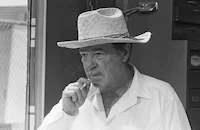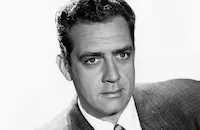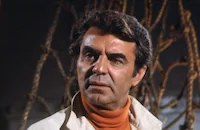Errol Flynn was in career doldrums when he agreed to star in Maru Maru (1952) for Warner Brothers. Ten years past a highly publicized court trial for statutory rape (the attendant media circus spawned the neologism "In like Flynn" as a synonym for sexual congress), the actor was deeply uninterested in his work, plagued by illness (Flynn suffered from back trouble, a weak heart, and recurrent malaria stemming from youthful adventures in Papua, New Guinea) and spiraling into substance abuse to ameliorate his pain and boredom. A consummate professional despite his demons, Flynn soldiered through production of Maru Maru in late 1951, playing a war veteran turned deep sea diver who is coerced by villain Raymond Burr into searching for a diamond cross off the coast of the Philippines. Flynn's leading lady was Warners contract player Ruth Roman, fresh from Alfred Hitchcock's Strangers on a Train (1951); Roman's greatest sea adventure was yet to come, however, when the actress and her 3 year-old son Richard (conceived just after Maru Maru wrapped) survived the sinking of the oceanliner SS Andrea Doria in 1956. Shot on location on Balboa Island and at San Pedro Harbor (standing in for the Port of Manila), Maru Maru is enlivened by the direction of Gordon Douglas (the 1954 sci-fi classic Them! lay just ahead for him) and the photography of Robert Burks, destined to become Alfred Hitchcock's cinematographer of choice for Rear Window (1954), Vertigo (1958), and North by Northwest (1959).
By Richard Harland Smith
Mara Maru

Brief Synopsis
A salvage diver is accused of murder while hunting a mysterious treasure.
Cast & Crew
Read More
Gordon Douglas
Director
Errol Flynn
Ruth Roman
Raymond Burr
Paul Picerni
Richard Webb
Film Details
Genre
Adventure
Release Date
1952
Production Company
Warner Bros. Pictures
Distribution Company
Warner Bros. Pictures Distribution
Technical Specs
Duration
1h 38m
Sound
Mono (RCA Sound System)
Color
Black and White
Theatrical Aspect Ratio
1.37 : 1
Synopsis
Greg Mason, salvage diver in the Philippines, finds his partner Andy drunk and raving about treasure. Whatever it is, somebody wants it badly enough to kill Andy and frame Mason for murder. Cleared by an insinuating private eye, Mason is immersed in intrigue, with detective Rainier, sinister Benedict, mysterious Orgega, and Andy's comely widow all somehow involved. Soon various parties, not really trusting each other, are on a sea voyage to dive for they know not what...
Director

Gordon Douglas
Director
Videos
Movie Clip


Film Details
Genre
Adventure
Release Date
1952
Production Company
Warner Bros. Pictures
Distribution Company
Warner Bros. Pictures Distribution
Technical Specs
Duration
1h 38m
Sound
Mono (RCA Sound System)
Color
Black and White
Theatrical Aspect Ratio
1.37 : 1
Articles
Mara Maru -

Mara Maru -
Errol Flynn was in career doldrums when he agreed to star in Maru Maru (1952) for Warner Brothers. Ten years past a highly publicized court trial for statutory rape (the attendant media circus spawned the neologism "In like Flynn" as a synonym for sexual congress), the actor was deeply uninterested in his work, plagued by illness (Flynn suffered from back trouble, a weak heart, and recurrent malaria stemming from youthful adventures in Papua, New Guinea) and spiraling into substance abuse to ameliorate his pain and boredom. A consummate professional despite his demons, Flynn soldiered through production of Maru Maru in late 1951, playing a war veteran turned deep sea diver who is coerced by villain Raymond Burr into searching for a diamond cross off the coast of the Philippines. Flynn's leading lady was Warners contract player Ruth Roman, fresh from Alfred Hitchcock's Strangers on a Train (1951); Roman's greatest sea adventure was yet to come, however, when the actress and her 3 year-old son Richard (conceived just after Maru Maru wrapped) survived the sinking of the oceanliner SS Andrea Doria in 1956. Shot on location on Balboa Island and at San Pedro Harbor (standing in for the Port of Manila), Maru Maru is enlivened by the direction of Gordon Douglas (the 1954 sci-fi classic Them! lay just ahead for him) and the photography of Robert Burks, destined to become Alfred Hitchcock's cinematographer of choice for Rear Window (1954), Vertigo (1958), and North by Northwest (1959).
By Richard Harland Smith


















